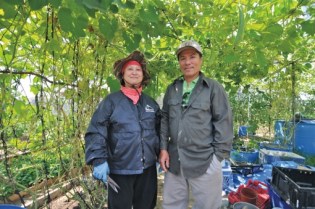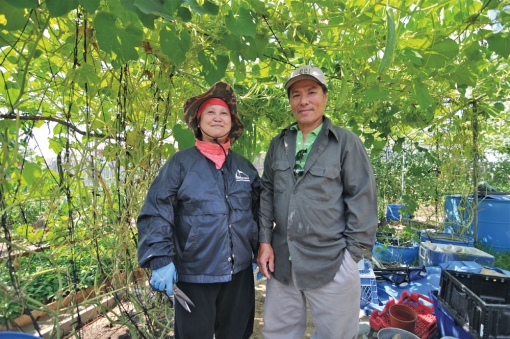This is the second half of a feature story from Hyphen Magazine’s Survival Issue. Read the first part here.
Recipe: South Vietnamese Bitter Melon
This is the kind of dish we have only at home, never in restaurants: Mix shrimp paste, sugar, red pepper and lots of lime juice into a sauce. Shave raw bitter melon very thinly. Dip in sauce and eat over rice.
— Jennifer Vu, New Orleans native

Xuy En Pham and her husband Joseph Mai turned their backyard into an urban farm when it was hard to get enough food after Katrina. (Photo by Lisa Cates.)
The uncertainty in the seafood industry goes beyond those who work the ocean. Many Asian Americans have capitalized on New Orleans’ food-loving culture, infusing their own flavor into a plethora of boiled-crab takeout joints, seafood po’boy shops and other small restaurants (one popular New Orleans Japanese restaurant serves edamame with chili sauce).
Beau Nguyen and his wife, Laura, operate Singleton’s Mini-Mart, a convenience store with a small lunch counter, in the Uptown neighborhood of New Orleans. Their shrimp po’boy is a hulking mass of fried seafood on a French bread roll, best washed down with a cold beer or iced tea.
Since the oil spill, the couple has seen fewer customers and higher seafood prices; oysters were off the menu for almost a year after the sensitive bivalves and their nesting beds reacted to the spill. The couple struggled to convince customers that their food was safe. To recoup their losses, they added a new Vietnamese weekend menu: grilled pork with rice noodles and pho advertised as a “Hangover Remedy” for nearby Loyola and Tulane students. The new menu is popular, but it’s much more work to produce two entirely different menus.
Beau and Laura’s success can be attributed not just to their food but also to the relationships they have built in their multiracial neighborhood. Beau stayed in the shop through the terrors of Katrina, and customers still talk about the food he gave to neighbors and the big pig he barbecued in his parking lot after that hurricane. Although Uptown is considered a wealthier neighborhood, the specter of poverty is never far in New Orleans. I saw a range of characters wander in and out of Singleton’s, ranging from the just-down-on-their-luck to the indigent. All got a kind word from Laura and sometimes a snack to get them through the day.
Very early on Saturday mornings, a strip mall parking lot in New Orleans East, about 20 minutes outside of the city center, transforms into a bustling morning market. Browsing the stalls are local African American, African, Mexican, and South Asian families who think nothing of cruising a parking lot at 5 a.m. to get the best produce. For them, “fresh and local” aren’t gourmet marketing terms. They simply define what the highest quality and cheapest food is.
Parking spaces overflow with huge bundles of basil, bags of mung bean sprouts, chayote (or mirlitons as they are called in New Orleans), cucumber, persimmons, green onions, bitter melon, steamed buns, chicken over noodles, and sweet sticky coconut rice just packed that morning. There’s a man with eggs, and the chickens who laid them. And fish, of course — so many fish.

A Vietnamese po’boy sandwich. (Photo by Lisa Cates.)
New Orleans East is the Vietnamese community’s historical and cultural heart. This is where refugee families were hastily settled after the war, in a public housing complex called the Versailles Arms Apartments. Those apartments are now boarded up, as families have been able to buy homes, move into town or join relatives in other parts of the country. The area is now roughly 33 percent Asian American and 50 percent African American, with a 26 percent poverty rate. Many Vietnamese still live nearby and return regularly: The Catholic church and Buddhist temple, the popular Dong Phuong Bakery, and ethnic markets are all there.
Food — and access to nutritious food like the kind sold at the Saturday market — has always been a priority for the area’s residents, many of whom lived in multiple refugee camps before settling in the American South. Leo S. Chiang’s 2009 film, A Village Called Versailles, depicted this area’s residents finding their political voice when a post-Katrina landfill threatened to pollute the kitchen gardens where they grew their food. Food security, defined by the World Health Organization as “access to sufficient, safe, nutritious food to maintain a healthy and active life,” is paramount for residents; that definition also includes access to familiar Asian foods, freshly grown and free of pollutants.
The BP oil spill highlighted the necessity of this local market, and Versailles-area residents are ramping up food production for both survival and income. Xuy En Pham and her husband, Joseph Mai, have attracted local notoriety for turning their entire yard into a miniature urban farm. Their house on East Lamont Street was so badly damaged by hurricanes Katrina and Rita that they bulldozed it, moved in with friends, and began to grow vegetables on the land. After the spill, they lost their jobs shucking oysters for Captain John’s Seafood, a local restaurant and seafood wholesaler. At that point, their hobby became a full-time pursuit with the urgency of finding a job and having something to eat.
Their skill is evident: long, neat rows of kohlrabi, mustard greens, onion, cucumber, and squash. Mai built intricate trellises from discarded boards and plastic twine, strong enough to support heavy gourds and squashes. They eat about 70 percent of the vegetables they grow and sell the rest at the morning market where they make around $30 to $40 a week.
While they received some relief payments from BP, those ended in December 2010. From then until the hot day I visited six months later, nothing. “We need help for living expenses,” Pham said through a translator. “We need help from BP to live.” The 63-year-old mother of 10 never stops working as we talk, her smooth skin and wide smile protected by handkerchiefs and a canvas hat.
Mai and Pham may never be able to reclaim what’s owed to them by oil companies or the government, but at least they know where their next meal will come from. It will come from their hands, their friends, and the strained land they have coaxed back into productivity.
This Vietnamese grandmother’s survivalist approach to rebuilding has inspired other local food- and agriculture-based development projects. Mary Queen of Vietnam Community Development Corporation, an economic development group affiliated with Mary Queen of Vietnam church, is planning an urban farm and land-based aquaculture fishing project for the community that would provide jobs and subsistence food for former fishermen as well as those returning from other parts of the United States after evacuating the area post-Katrina.
And people are returning. According to a Tulane University study, Vietnamese New Orleanians had one of the highest rates of return after Hurricane Katrina among all ethnic groups. Despite the setbacks, something holds Vietnamese Americans here and gives them hope for the future. It might be something in the food.
Recipe: Coming Home Chicken Soup (Chao)
Chao is just rice cooked with a lot of water. I call it swill. You can do many different flavors, but the most common is chicken.
Boil a chicken with onion, and take out the chicken. Separate the meat from the bone, and drop the carcass back into the juice. Keep on simmering, boiling it, and just when you’re almost ready to eat, drop a handful of rice into the pot. Not too much. After about half an hour, it should be ready. In the meantime, break the chicken down into smaller pieces. Before you serve, you can put all the chicken meat back in or keep it separate and let people put their own in as they eat. Normally you would add green onions, chopped cilantro, and a little bit of black pepper. If it’s not salty enough, add a little fish sauce. That’s it. It’s good for sharing.
— The Rev. Vien Nguyen, who often serves this to guests and family members returning from long trips.



